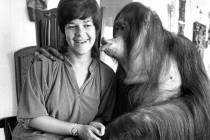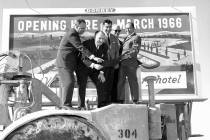Physical remains of Moulin Rouge should go; its history will stay
Guilt-ridden about betraying my core beliefs about historic preservation, I found myself agreeing with Las Vegas Mayor Oscar Goodman: It’s time for the Moulin Rouge to go.
Nobody is going to resurrect Las Vegas’ first integrated casino. It has been through too many fires, too many people have promised to revive it, only to fail. Honestly, (and the Las Vegas Review-Journal is just a few blocks away on Bonanza Road) the area is not the right place for a $700 million resort, the latest fantasy, which was pitched last year.
But as someone who scoffs at the Las Vegas tradition of blowing up anything that stands in the way of progress, I hoped someone might talk me out of my stance. For perspective, I reached out to one of the strongest advocates of historic preservation in Nevada — Bob Stoldal.
Maybe he could change my mind and make the argument the place doesn’t deserve to be demolished, even though from the pitiful looks of it, that would be an act of mercy. The last fire in May did a good job of making the place look deserving of the famed Bette Davis utterance, "What a dump."
Stoldal knocked me over. Instead of chiding me, he agreed with me, as well as the mayor, who had the guts to first say it publicly.
Even Las Vegas City Councilman Ricki Barlow, who represents the area, agreed with the mayor’s analysis that the site is blight.
In what now looks like extraordinary timing, the Las Vegas Centennial Commission paid $11,162 to move the sprawling Moulin Rouge sign to the Neon Museum’s Boneyard just before the May fire. "That sign will be preserved if I have anything to do with it. The sign represents the spirit of the place," said Stoldal, now the executive vice president of news at Sunbelt Corporation and a member of the centennial commission.
The Moulin Rouge’s spirit has lasted 54 years, but what many forget is that it was only an active casino for about 51/2 months, opening May 24, 1955, and closing in October. After that, it never rallied as a successful business. But for 54 years, the Moulin Rouge represented a civil rights victory, a hotel-casino in a black neighborhood where both blacks and whites mingled in an otherwise segregated city.
"That spirit has always transcended that short period of time," Stoldal said. "It set a line in the sand, that things needed to change in the battle for civil rights."
Stoldal called the opening of the Moulin Rouge "that moment of transition in our community."
Civil rights marches started there. In 1960, government and gaming officials met with activists there and hammered out a desegregation plan for casinos downtown and on the Strip.
My personal recollection of the Moulin Rouge was election night 1991 when Las Vegas Councilman Frank Hawkins defeated Nicole Stupak despite extensive coverage by the R-J about his ethics. The newspaper was accused of being racist, and I was there to cover Hawkins’ speech. When I started to leave, an African-American man offered to escort me to my car. I sensed enough hostility from the crowd that I accepted his kind offer.
Bob Bailey and his wife, Anna, were among the original performers there, and in his book "Looking Up!: Finding my Voice in Las Vegas," he described seeing for the first time "this elegant, bright, pale-yellow building" with palm trees on the outside. Inside, the walls were covered in polished mahogany paneling and crystal chandeliers. "It was as beautiful as anything I’d ever seen in New York," Bailey wrote, and it brought a new surge of black energy to Nevada.
Yet Bailey agreed with me. "It’s time to move on. There will never be another Moulin Rouge, but it’s played its role in history."
The 900 W. Bonanza Road 17-acre site is no longer a site for a casino. It needs to be cleared off, and maybe someone will see it as a commercial site. The current owner, Olympic Coast Investment, wants nothing more than to sell the land.
Memories of peaceful integration and civil rights victories won’t disappear once the remaining buildings are gone.
But those sad-looking remnants need to go.
Jane Ann Morrison’s column appears Monday, Thursday and Saturday. E-mail her at Jane@reviewjournal.com or call (702) 383-0275. She also blogs at lvrj.com/blogs/morrison.












